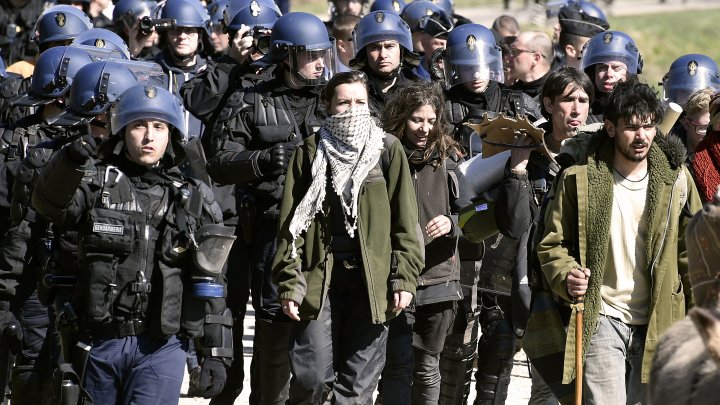March 7th, 2015
A bitter battle over a dam that has pitted French farmers against environmentalists may have finally come to an close Friday following a ruling by local leaders, though the former are likely to be happiest with the decision.
The departmental council in Tarn, southwest France, voted in favour 46 to 43 of creating a dam and reservoir at around half the size of the originally proposed project.
They also asked the government to forcibly remove “without delay” a group of environmental protesters who have occupied the site of the proposed Sivens dam for the past nine months in an effort to block construction.
A little over an hour later, armed police entered the area to begin clearing the protesters’ camp.
Protests, barricades and tragedy
It may be the final chapter of a saga that has been the source of intense dispute in France for several years – and resulted in the death of at least one protester.
The project, for which planning began in 1989, was conceived to provide better irrigation for local farms by damming the River Tescou to create a reservoir.
After years of deliberation and feasibility studies, the final plans were given official approval in 2004, envisioning the creation of a reservoir holding 1.5 million cubic metres of water.
But the €8.4m-project faced fierce opposition from the start from environmentalists, including France’s green party the EELV, who argued it would mean the destruction of several hectares of wetlands – a haven for wildlife – and benefit only a small number of farms.
In October 2013, members of a radical environmentalist group known as the “Zadistes” began occupying the construction site. Police twice removed the protesters from the site, most recently in May 2014, but both times they returned.
Then, one year later, the dam project made international headlines after a 21-year-old environmental activist, Rémi Fraisse, was killed during a protest after being struck on the head by a flash grenade thrown by police.
His death triggered demonstrations in several cities in France against police brutality, which themselves led to violent clashes with authorities.
The protesters have also provoked the ire of local farmers, who support the dam. Most recently, around 130 farmers set up barricades to stop activists from accessing the site.
Finally, on October 31, 2014, work on the dam was halted and the original plans for the project scrapped entirely by Ecology Minister Ségolène Royal the following January.
Royal gave local authorities two options: build a smaller reservoir of about 750,000 cubic metres further upstream from the original site, or build four separate (and smaller) reservoirs.
It was this first option the general council opted for on Friday, judging the second scenario too expensive.
Council president Thierry Carcenac told AFP that further studies would be carried out to determine exactly where the new reservoir would be built, adding that there was a “leeway of plus or minus 10 percent” on the final size of the dam.
Farmers happy, environmentalists scepical
The government, so long stuck between a rock and a hard place – unable to please both farmers and environmentalists – will be hoping a compromise acceptable to both sides has now been reached.
In a joint statement, Royal and Agriculture Minister Stéphane Le Foll welcomed the council’s decision. The new plan, they said, “while meeting all the criteria of environmental protection, will secure the water supply necessary for agricultural production at a much higher rate.”
However, initial reactions suggest the farmers may be happier than the environmentalists with Friday’s decision.
The FNSEA farmers’ union praised the council’s “courage” and said it now wanted to see “the respect of law, the evacuation of the Zadistes and construction work to start without delay”.
The EELV, in contrast, said the revised project “in the end resolves nothing”, though it welcomed the abandonment of the original plans.
“In the absence of additional studies, there is nothing to suggest that legal doubts over respect for the environment have been alleviated,” the party said in a statement.
Meanwhile, there appeared to be mixed reactions from protesters as the police moved in to disband their camp on Friday.
“Most left the scene quietly,” police spokesperson Stéphane Rappailles told Reuters.
However, others were less willing to give in. Around 25 Zadistes had to be forcibly removed, said Rappailles, while six were arrested.
“[We will] hide in the woods,” one protester, named Christian, told AFP. “We will not leave.”


